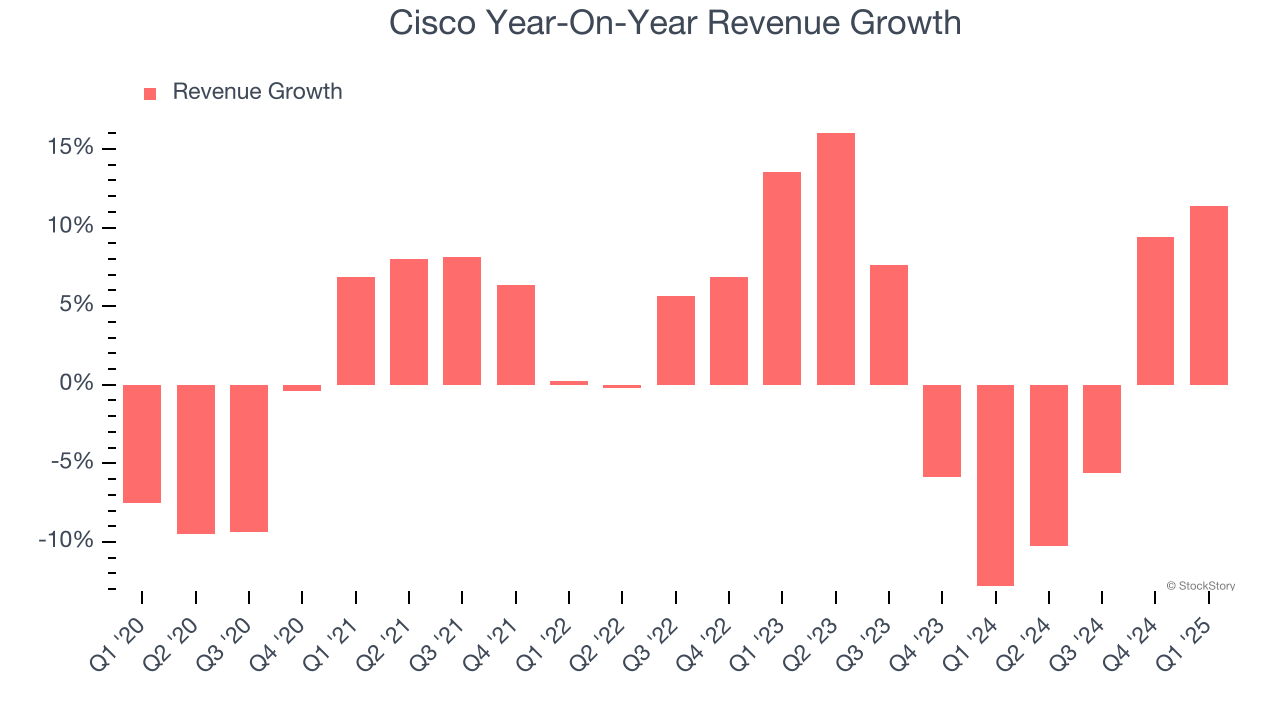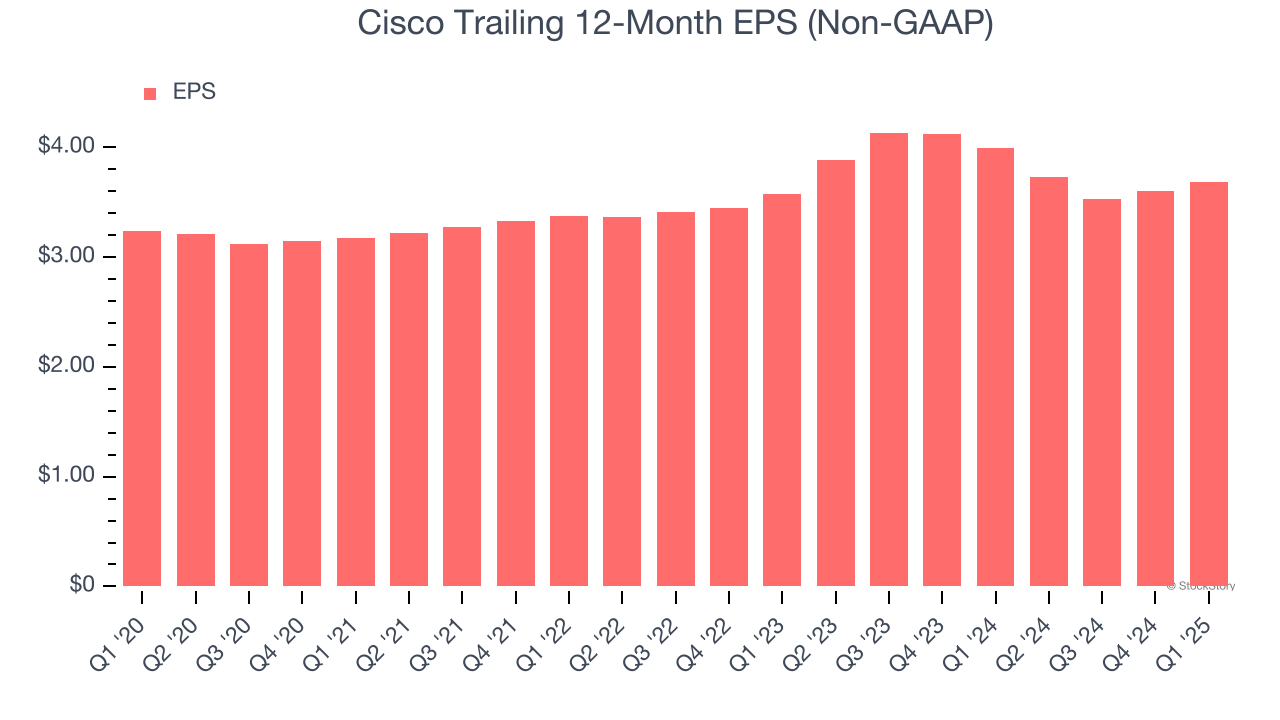
Networking technology giant Cisco (NASDAQ:CSCO) reported Q1 CY2025 results topping the market’s revenue expectations, with sales up 11.4% year on year to $14.15 billion. Guidance for next quarter’s revenue was better than expected at $14.6 billion at the midpoint, 0.5% above analysts’ estimates. Its non-GAAP profit of $0.96 per share was 4.6% above analysts’ consensus estimates.
Is now the time to buy Cisco? Find out by accessing our full research report, it’s free.
Cisco (CSCO) Q1 CY2025 Highlights:
- Revenue: $14.15 billion vs analyst estimates of $14.06 billion (11.4% year-on-year growth, 0.7% beat)
- Adjusted EPS: $0.96 vs analyst estimates of $0.92 (4.6% beat)
- Adjusted EBITDA: $4.77 billion vs analyst estimates of $5.34 billion (33.7% margin, 10.6% miss)
- Revenue Guidance for Q2 CY2025 is $14.6 billion at the midpoint, roughly in line with what analysts were expecting
- Management raised its full-year Adjusted EPS guidance to $3.78 at the midpoint, a 1.9% increase
- Operating Margin: 22.6%, up from 17.2% in the same quarter last year
- Free Cash Flow Margin: 26.8%, down from 29.9% in the same quarter last year
- Market Capitalization: $245.8 billion
"Cisco once again had strong quarterly results with clear demand for our technologies," said Chuck Robbins, chair and CEO of Cisco.
Company Overview
Founded in 1984 by a husband and wife team who wanted computers at Stanford to talk to computers at UC Berkeley, Cisco (NASDAQ:CSCO) designs and sells networking equipment, security solutions, and collaboration tools that help businesses connect their systems and secure their digital operations.
Sales Growth
Examining a company’s long-term performance can provide clues about its quality. Any business can have short-term success, but a top-tier one grows for years.
With $55.62 billion in revenue over the past 12 months, Cisco is a behemoth in the business services sector and benefits from economies of scale, giving it an edge in distribution. This also enables it to gain more leverage on its fixed costs than smaller competitors and the flexibility to offer lower prices. However, its scale is a double-edged sword because it’s challenging to maintain high growth rates when you’ve already captured a large portion of the addressable market. To expand meaningfully, Cisco likely needs to tweak its prices, innovate with new offerings, or enter new markets.
As you can see below, Cisco’s 1.9% annualized revenue growth over the last five years was sluggish. This shows it failed to generate demand in any major way and is a rough starting point for our analysis.

Long-term growth is the most important, but within business services, a half-decade historical view may miss new innovations or demand cycles. Cisco’s recent performance shows its demand has slowed as its revenue was flat over the last two years. 
This quarter, Cisco reported year-on-year revenue growth of 11.4%, and its $14.15 billion of revenue exceeded Wall Street’s estimates by 0.7%. Company management is currently guiding for a 7% year-on-year increase in sales next quarter.
Looking further ahead, sell-side analysts expect revenue to grow 5.1% over the next 12 months, an improvement versus the last two years. This projection is above the sector average and suggests its newer products and services will fuel better top-line performance.
Today’s young investors won’t have read the timeless lessons in Gorilla Game: Picking Winners In High Technology because it was written more than 20 years ago when Microsoft and Apple were first establishing their supremacy. But if we apply the same principles, then enterprise software stocks leveraging their own generative AI capabilities may well be the Gorillas of the future. So, in that spirit, we are excited to present our Special Free Report on a profitable, fast-growing enterprise software stock that is already riding the automation wave and looking to catch the generative AI next.
Operating Margin
Cisco has been a well-oiled machine over the last five years. It demonstrated elite profitability for a business services business, boasting an average operating margin of 24.8%.
Analyzing the trend in its profitability, Cisco’s operating margin decreased by 5.3 percentage points over the last five years. This raises questions about the company’s expense base because its revenue growth should have given it leverage on its fixed costs, resulting in better economies of scale and profitability.

In Q1, Cisco generated an operating profit margin of 22.6%, up 5.4 percentage points year on year. This increase was a welcome development and shows it was more efficient.
Earnings Per Share
Revenue trends explain a company’s historical growth, but the long-term change in earnings per share (EPS) points to the profitability of that growth – for example, a company could inflate its sales through excessive spending on advertising and promotions.
Cisco’s weak 2.6% annual EPS growth over the last five years aligns with its revenue performance. This tells us it maintained its per-share profitability as it expanded.

In Q1, Cisco reported EPS at $0.96, up from $0.88 in the same quarter last year. This print beat analysts’ estimates by 4.6%. Over the next 12 months, Wall Street expects Cisco’s full-year EPS of $3.69 to grow 5.7%.
Key Takeaways from Cisco’s Q1 Results
We enjoyed seeing Cisco increase its EPS guidance for next quarter. We were also happy its revenue and EPS outperformed Wall Street’s estimates. On the other hand, its EBITDA missed, but this print still had some key positives. The stock traded up 3.5% to $63.42 immediately following the results.
Indeed, Cisco had a rock-solid quarterly earnings result, but is this stock a good investment here? The latest quarter does matter, but not nearly as much as longer-term fundamentals and valuation, when deciding if the stock is a buy. We cover that in our actionable full research report which you can read here, it’s free.
